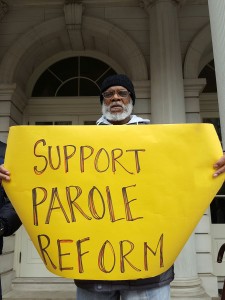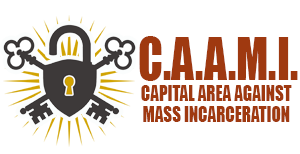Parole Justice: What’s the Score?
by Naomi Jaffe, of CAAMI and the New York State Prisoner Justice Network
To become more involved with CAAMI’s Parole Justice work, e-mail nycaami@gmail.com
 Many of us who fight to change New York’s prison system know its hard realities first hand, and many more of us know them second hand, through years of exhausting trips to visit our loved ones in distant prisons. We have felt the pain of hopes dashed for years and decades by a parole board that seemingly does not see us as fellow humans but only as examples of badness that can never change. We have seen parole board decisions that make no sense on the level of community safety, morality, compassion, or respect for the law – decisions that can only be understood as coming from a commitment to endless punishment and from accountability to forces with a stake in increasing mass incarceration.
Many of us who fight to change New York’s prison system know its hard realities first hand, and many more of us know them second hand, through years of exhausting trips to visit our loved ones in distant prisons. We have felt the pain of hopes dashed for years and decades by a parole board that seemingly does not see us as fellow humans but only as examples of badness that can never change. We have seen parole board decisions that make no sense on the level of community safety, morality, compassion, or respect for the law – decisions that can only be understood as coming from a commitment to endless punishment and from accountability to forces with a stake in increasing mass incarceration.
But even some of us who have watched this process close up for years were horrified by recent research into the workings of the parole board, collected by advocates to pressure the governor and the legislature to make changes in the composition of the board. We found out that most or all of the parole commissioners, who earn more than $100,000 a year, make substantial contributions to the reelection campaigns of the members of the Senate committee that confirms their appointments. The racial bias we have seen all along was proven by the different outcomes for parole applicants of different races with similar records. And worst of all, only around a third of the thousands who come before the parole board each year – AFTER serving their full minimum sentences — are released.
Quotes gathered from actual parole hearings confirmed what we already knew: arrogance, cruelty, and incompetence are rampant. Here the commissioners, with no legal process and allowing no defense, are heard retrying the original crime, acting as judge, jury, accuser, prosecutor, and sentencing court.
Parole Commissioner: How many burgs have you done that you haven’t been nailed for? There are others out there. What do you figure? Five, six? How many?
Applicant: No sir, this is the only one.
Parole Commissioner: How many days in advance had you been planning to kill her?
Applicant: I didn’t plan it. There was so much bad energy that developed over the years that… we didn’t know how to deal with it.
Parole Commissioner: You are not answering my questions. I am asking very specific directed questions and you cannot articulate to me how you elevated your bad relationship into this murder…
Parole Commissioner: She had a bike chain around her neck also?
Applicant: A what? Oh sir, I don’t know where that [misinformation] came from.
Parole Commissioner: In support of your claim of serious abuse, you offered little more than your own testimony and the opinion of an expert… You didn’t offer a single credible witness… We’ll have to take your version of events and the official version and we’ll have to try to determine which is more credible.
The parole justice movement that gathered this information and made it public is a window into the contradictions of our time: terrible injustice, and a vibrant movement fighting hard against it.
The last few months have been an amazing time for the struggle for parole justice and against mass incarceration. The May 10th statewide day of advocacy and action in Albany kicked off a month of intensive lobbying as the legislative session came to a close. The statewide multi-issue collaborative movement for prisoner justice achieved a level of visibility and credibility that could scarcely have been imagined even five years ago. There were media exposés of the profound racial disparities in the system; political officials mouthing the phrase “mass incarceration” like they invented it; “respectable” non-profits that wouldn’t give our grassroots groups the time of day jumping on the “criminal justice reform” bandwagon now that it’s rolling.
All this hullaballoo is frustratingly slow to translate into actual changes behind the bars. But there were a few significant anti-incarceration victories.
- Through letters, petitions, faxes, phone calls, press conferences and more, we beat back an initiative by Governor Cuomo to reduce visiting days in New York’s maximum security prisons.
- The HALT (Humane Alternatives to Long-Term) Solitary Confinement bill generated a lot of visibility to the massive use of solitary in New York State. The bill picked up an impressive roster of legislative sponsors and has a reasonable chance of passage in 2018.
- In New York City, the Close Rikers campaign won a promise from Mayor DiBlasio to move toward closure within ten years.
- A flawed but better than nothing Raise the Age bill was passed. Too bad they didn’t heed our movement’s slogan, “All children, all charges.” Nevertheless it will significantly affect the fates of many children and youth caught up in the criminal Injustice system.
- The SAFE (Safe and Fair Evaluations) Parole Act, written by prisoners and advocates to mandate fairer parole decisions, gained additional sponsors, media coverage, and public recognition. A bill sponsored by Assembly Member Weprin, Chair of the Corrections Committee, picked up on one of SAFE’s provisions: prison administrators must prioritize needed programs for parole applicants who are denied because those programs are not available.
- A terrible bill to extend the waiting period between parole hearings from 2 years to 5 years for certain crimes was defeated.
- And the most exciting, though limited, victory: through coordinated pressure on the governor and the legislature, we won some changes in the composition of the parole board! For the first time in living memory, our communities had an impact on the selection of those who have so much power over us and our loved ones. Advocates pressed the governor not to reappoint the five board members whose terms expired – Otis Cruse, James Ferguson, Kevin Ludlow, Julie Smith, and William Smith. Documentation was sent to the governor and the legislature showing that these parole commissioners consistently act with disregard for the laws they are supposed to be implementing, refuse to be guided by risk and needs principles, and see themselves as above the judiciary, the legislature, and scientific penal practices. The result was that the governor renominated only two, O. Cruse and W. Smith. It is not clear how long the others will be held over without being reappointed. In addition, the governor sent six new candidates to the Senate Crime Victims Committee for confirmation, representing considerably more regional, racial, and professional diversity than the board has seen in many a year. The two old and six new appointees were all confirmed by the Senate.
The final score for the 2017 legislative session: we haven’t won yet – but we haven’t lost yet either!
